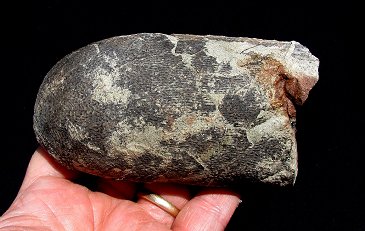|
Name: Oviraptor Egg (with Embyonic Yolk)
Age: Cretaceous
Formation: Nanxiong Formation
Location: Guangdong Province, China
Size: he egg is 4.7 inches across!
Price: SOLD
Specimen SSDD1
|
Yes, this is a REAL dinosaur egg! This egg is from the dinosaur, Oviraptor, or ''egg robber''. Most raptors laid their eggs in nests of a dozen or more eggs. Oviraptor mothers have been found fossilized guarding their nests, showing a ''nurturing'' nature in these dinosaurs. Usually, hatching and scavenging damaged the nests, obliterating any trace of the eggs that remained. Occasionally, some eggs survived predators and the elements, and eventually became fossils. Another point of interest relating to our raptor eggs is the overall comparison of eggshell thickness of these eggs. The raptor eggs found in deepest deposits (older) have very thick eggshell. As you examine eggs higher in the formation (younger), you see a gradual thinning of the eggshell over time. Gradual changes in vegetation (determined from pollen samples), changes in climate from a humid subtropic to an arid temperate region, and less oxygen in the air (determined from examining air trapped in amber) could have weakened the dinosaurs ability to produce healthy eggs, thus leading to their inevitable extinction. Environmental stresses in modern birds (the brown pelican, for example) have been shown to reduce the thickness of eggshells and the results on the species are similar. Because of their delicate nature, recognizable eggs are very rare in the fossil record. Dinosaur eggs that retain their original shape, eggshell, and embryonic contents are among the most collectible fossils in the world.
This is a special dinosaur fossil. It is a textbook Raptor (Oviraptor) egg with embryonic remains preserved. This amazing specimen was acquired at the Tucson Fossil Show in 1992. This UNHATCHED egg was discovered and unearthed, then one end of the egg was removed - that exposed where the fossilized embryo (white spots) is preserved directly under the surface/shell of the egg. These areas contain embryonic remains - either "yolk" or actual bones or other structures - you'll need a very high-powered microscope to see details that minute. I examined these areas, and I see some sort of structure, but I can't really tell what I am looking at- I don't know the anatomy of dinosaur embryos whatsoever. I do know only a handful of dinosaur eggs have ever been found with traces of embryonic remains preserved - this is may be a once-in-a-lifetime opportunity to acquire a dinosaur fossil this special and collectible.
|



